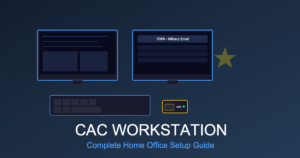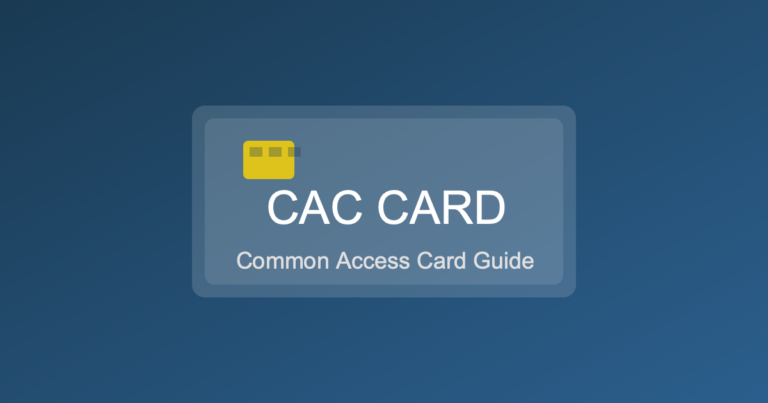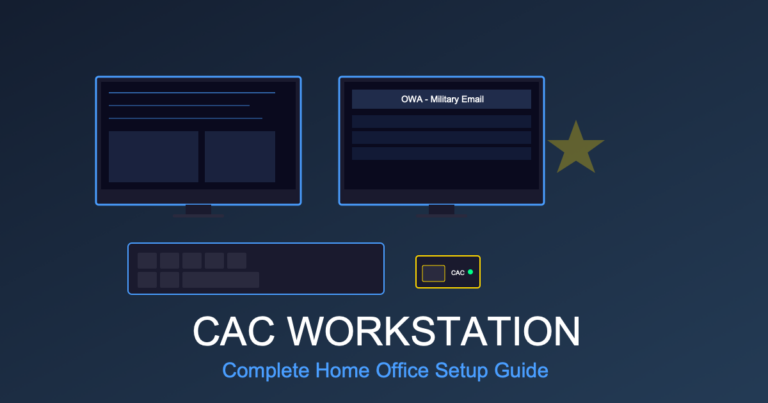CAC PIV Differences: Understanding DoD vs Federal ID Cards
CAC and PIV cards look similar, both provide smart card authentication, and both enable facility access and system login – but they’re issued by different government sectors for different purposes. Understanding the differences between DoD’s Common Access Card (CAC) and federal agencies’ Personal Identity Verification (PIV) cards is essential if you work in joint environments, transition from military to civilian federal service, or support cross-agency operations.
This comprehensive guide explains what CAC and PIV cards are, key differences in issuance and usage, technical compatibility, which systems accept which cards, and what happens when transitioning between DoD and federal civilian employment.
What Is a CAC Card?
CAC: Common Access Card
Issuing authority: Department of Defense (DoD)
Who gets CAC:
- Active duty military (all branches including Space Force and Coast Guard)
- Reserve and National Guard members
- DoD civilian employees
- DoD contractors with appropriate sponsorship
- Eligible dependents (dependent ID, different from standard CAC)
Primary purposes:
- DoD facility physical access (bases, installations, buildings)
- NIPR and SIPR network authentication
- DoD email (@mail.mil domains)
- PKI digital signatures and encryption
- Two-factor authentication for DoD systems
CAC Technical Details
- Standard: Conforms to HSPD-12 and FIPS 201
- Smart card chip: Contains digital certificates, biometrics, photos
- Validity period: 3 years (5 years for some civilians)
- Visual appearance: Photo ID with DoD seal, rank/grade, affiliation
- Color scheme: Varies by status (green for active duty, blue for contractors, etc.)
What Is a PIV Card?
PIV: Personal Identity Verification
Issuing authority: Federal agencies (non-DoD) per HSPD-12 directive
Who gets PIV:
- Federal civilian employees (non-DoD agencies)
- Contractors supporting federal agencies
- Examples: Department of Homeland Security, Department of State, NASA, FBI, USDA, VA, etc.
Primary purposes:
- Federal facility physical access
- Federal network authentication
- Federal email (@agency.gov domains)
- PKI digital signatures and encryption
- Two-factor authentication for federal systems
PIV Technical Details
- Standard: FIPS 201 (Federal Information Processing Standard)
- Smart card chip: Contains digital certificates, fingerprints, photos
- Validity period: Varies by agency (typically 3-6 years)
- Visual appearance: Photo ID with agency seal, no rank/grade
- Color scheme: Varies by agency (often blue, green, or agency-specific colors)
CAC vs PIV: Key Differences
| Aspect | CAC (DoD) | PIV (Federal) |
|---|---|---|
| Issuing Organization | Department of Defense | Federal agencies (non-DoD) |
| Primary Users | Military, DoD civilians, DoD contractors | Federal civilians, federal contractors |
| Issuance Location | RAPIDS sites (on military installations) | Agency-specific PIV offices |
| Standard | FIPS 201 compliant + DoD-specific requirements | FIPS 201 compliant |
| Physical Access | DoD facilities, bases, installations | Federal agency buildings |
| Network Access | NIPR, SIPR, JWICS (with clearance) | Agency networks (varies by agency) |
| Email Domain | @mail.mil, @us.af.mil, @navy.mil, etc. | @agency.gov (e.g., @dhs.gov, @state.gov) |
| Rank/Grade Display | Yes (military rank or civilian grade) | No (just name and photo) |
| Color Coding | Yes (green, blue, red, tan based on affiliation) | Varies by agency |
| Dependent IDs | Yes (separate dependent ID cards) | No (PIV for employees/contractors only) |
Technical Compatibility: Can CAC and PIV Interoperate?
FIPS 201 Compliance
Both CAC and PIV comply with FIPS 201 (Federal Information Processing Standard 201), which defines requirements for federal identity credentials.
What this means:
- Both cards use same cryptographic standards
- Both contain similar certificate types
- Both work with FIPS 201-compliant card readers
- Both support PKI authentication
Theoretical compatibility: Any FIPS 201-compliant system should accept both CAC and PIV.
Practical reality: Systems often configured to accept only specific card types due to policy, not technical limitations.
Certificate Differences
While both use PKI certificates, issuers differ:
- CAC certificates: Issued by DoD PKI Certificate Authorities (DoD Root CA 3, 4, 5, etc.)
- PIV certificates: Issued by various Federal PKI CAs (depends on agency)
Impact: Systems must trust the appropriate certificate authority. DoD systems trust DoD CAs; federal systems trust Federal Bridge CA and agency-specific CAs.
Reader Compatibility
Good news: CAC and PIV cards are physically identical smart card format (ISO 7816).
- Any CAC reader can read PIV cards
- Any PIV reader can read CAC cards
- Same USB readers work for both
- Same middleware (ActivClient, OpenSC) supports both
What varies: Not the reader hardware, but whether the connected system trusts certificates from that card.
Cross-Agency Access: When CAC and PIV Interact
Scenario 1: Military Member Visiting Federal Agency
Physical access:
- CAC may grant building access at federal facility
- Depends on agency policy and security system configuration
- Many agencies accept CAC for visitor access
- May require pre-registration or escort
Logical access (computer login):
- CAC typically does NOT work on federal agency networks
- Agencies configure systems to trust their own PIV CAs, not DoD CAs
- Visitor may need temporary PIV or guest account
Scenario 2: Federal Employee Visiting DoD Facility
Physical access:
- PIV may grant base access depending on installation
- Visitor Control Center may accept PIV for temporary access
- Some installations require advance coordination
Logical access (NIPR/SIPR login):
- PIV typically does NOT work on DoD networks
- DoD systems configured to trust DoD PKI, not all Federal PKI
- Federal employee may need sponsored temporary CAC for extended DoD work
Scenario 3: Joint Duty Assignment (Military at Federal Agency)
Typical solution: Dual credentials
- Keep CAC: Maintains DoD access, email, benefits systems
- Receive PIV: Agency issues PIV for daily work on agency systems
- Carry both: Use CAC for DoD systems, PIV for agency systems
- Confusion potential: Must track which card for which system
Federal Bridge CA: The Interoperability Solution
The Federal Bridge Certification Authority (FBCA) enables cross-certification between DoD PKI and Federal PKI.
What it does:
- Creates trust relationships between DoD and federal agency CAs
- Enables CAC certificates to be trusted by some federal systems
- Enables PIV certificates to be trusted by some DoD systems
Limitations:
- Not all systems participate in Federal Bridge
- Requires system administrators to configure cross-certification
- Often implemented inconsistently across agencies
- Complex certificate chain validation can cause issues
Bottom line: Federal Bridge theoretically enables interoperability, but practical implementation varies widely.
Transitioning from Military to Federal Civilian
Separating from Military Service
What happens to your CAC:
- CAC typically deactivated on separation date
- Some services allow 90-day grace period for retirees
- Must physically return CAC to installation (or cut and mail)
- CAC becomes invalid for DoD system access after separation
If transitioning to federal civilian job:
- New agency initiates PIV application during onboarding
- Background investigation transfers or reinitiated (depends on clearance)
- Schedule PIV issuance appointment at agency PIV office
- Receive PIV card (typically within 2-4 weeks of start date)
Gap period:
- There’s often a gap between CAC deactivation and PIV issuance
- May receive temporary agency badge for physical access
- May use temporary password authentication until PIV arrives
- Plan for 2-4 week period without smart card access
Retiring from Military
Retiree CAC (gray card):
- Military retirees can obtain retiree CAC after retirement
- Provides commissary, exchange, MWR facility access
- Provides access to some veteran services
- Does NOT provide: DoD network access, email, or system authentication
- Different from active duty CAC – limited functionality
If starting federal civilian job after retirement:
- Obtain PIV from new agency (retiree CAC doesn’t substitute)
- Maintain both: retiree CAC for veteran benefits, PIV for work
Federal Civilian to DoD Civilian
Transitioning from non-DoD federal agency to DoD civilian position:
- New DoD organization sponsors CAC application
- Schedule RAPIDS appointment
- Receive CAC (can be same-day at RAPIDS)
- Old agency PIV typically deactivated on separation
- Return old PIV to agency per policy
Clearance transfer:
- Security clearances often transfer between federal and DoD
- Requires reciprocity agreement and verification
- May require additional investigation if moving to higher classification
Specific System Compatibility
Systems That Accept Both CAC and PIV
- Some GSA facilities: Accept both for physical access
- Federal Bridge-enabled systems: If configured properly
- DoD Safe: Accepts both CAC and PIV for file sharing
- Some joint DoD/civilian systems: Configured for dual authentication
Systems That Typically Accept Only CAC
- NIPR (DoD network login)
- SIPR (DoD classified network)
- DoD email (@mail.mil)
- Most DoD-specific applications and portals
- Installation access control (military bases)
Systems That Typically Accept Only PIV
- Federal agency network logins (non-DoD)
- Agency email systems (@agency.gov)
- Agency-specific applications
- Federal building access control systems
Special Cases: Dual Credentials
Who Might Have Both CAC and PIV
- Military on joint assignment: Military member detailed to civilian agency
- DoD civilians supporting joint operations: DoD employee working closely with DHS, State, etc.
- Dual-hatted positions: Person with responsibilities in both DoD and civilian sectors
- Contractors supporting multiple agencies: Contractor with contracts at both DoD and civilian agencies
Managing Dual Credentials
Challenges:
- Must track which card for which system
- Need two CAC readers or swap cards frequently
- Must secure both cards (losing either is security incident)
- PINs may differ (must remember two PINs)
- Expiration dates likely differ (track two renewal cycles)
Best practices:
- Label cards or readers clearly
- Use different color lanyards to distinguish cards
- Keep both PINs securely documented (not written together)
- Set calendar reminders for both expiration dates
- Understand which card to use for each system before attempting login
Card Reader Considerations
Single Reader for Both Cards
Advantages:
- Less equipment clutter on desk
- Lower cost (one reader instead of two)
- Works fine if you use only one card at a time
Disadvantages:
- Must swap cards when switching between systems
- Easy to forget which card is inserted
- Wear on card contacts from frequent insertion/removal
Dual Readers
Advantages:
- Both cards always available
- No swapping required when switching systems
- Clear separation (left reader = CAC, right reader = PIV)
Disadvantages:
- Requires two USB ports
- More desk space needed
- Higher cost
Recommendation: If you regularly use both cards, dual readers significantly improve workflow efficiency.
Security Considerations
Protecting Both Credentials
- Both CAC and PIV are sensitive government property
- Loss of either requires immediate reporting
- Keep both secured when not in use
- Don’t leave either card in reader unattended
- Report lost/stolen immediately to both issuing organizations
Spillage Concerns
If you have access to both DoD systems (via CAC) and civilian systems (via PIV):
- Be aware of classification boundaries
- Don’t mix DoD classified information with civilian unclassified systems
- Understand information sharing agreements between organizations
- When in doubt, check with security office before sharing information cross-agency
Frequently Asked Questions
Can I use my CAC on a federal civilian computer?
Physical reader: Yes, reader will read the card.
System authentication: Usually no – federal systems typically don’t trust DoD PKI certificates unless specifically configured.
Can I use my PIV on a DoD computer?
Physical reader: Yes, reader will read the card.
System authentication: Usually no – DoD systems typically don’t trust non-DoD PKI certificates unless Federal Bridge configured.
If I have a security clearance with DoD, does it transfer to federal civilian?
Often yes, but:
- Clearances can transfer via reciprocity
- Receiving agency must accept the clearance
- May require additional investigation if clearance level changes
- Must have continuous service (no break exceeding 24 months typically)
Do I need to return my CAC when I get a PIV?
Depends:
- If leaving DoD employment: Yes, return CAC
- If maintaining DoD role while also having federal role (dual-hatted): No, keep both
Can contractors have both CAC and PIV?
Yes, if they support contracts at both DoD and civilian federal agencies. Each organization sponsors the respective credential.
Conclusion
CAC and PIV cards serve similar purposes – smart card authentication, facility access, and PKI services – but for different government sectors. CAC is DoD’s credential for military, DoD civilians, and DoD contractors. PIV is the federal civilian credential for non-DoD agencies. While both comply with FIPS 201 standards and use compatible hardware, they’re issued by different authorities with different certificate chains, limiting cross-agency interoperability in practice.
Transitioning between military and federal civilian service typically requires surrendering your old credential and obtaining a new one. Joint assignments may result in holding both credentials simultaneously, requiring careful management of which card to use for which systems.
The Federal Bridge CA enables some interoperability, but practical implementation varies by agency and system. When working in joint DoD/civilian environments, expect to need the appropriate credential for each system – CAC for DoD systems, PIV for civilian agency systems.
Related Guides:









